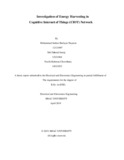| dc.contributor.advisor | Sabuj, Saifur Rahman | |
| dc.contributor.author | Nayeem, Mohammad Sultan Shafayat | |
| dc.contributor.author | Imtiaj, Md.Tahmid | |
| dc.contributor.author | Chowdhury, Nazifa Rahman | |
| dc.date.accessioned | 2019-07-03T08:05:45Z | |
| dc.date.available | 2019-07-03T08:05:45Z | |
| dc.date.copyright | 2019 | |
| dc.date.issued | 2019-04 | |
| dc.identifier.other | ID 12121007 | |
| dc.identifier.other | ID 12221064 | |
| dc.identifier.other | ID 14321053 | |
| dc.identifier.uri | http://hdl.handle.net/10361/12300 | |
| dc.description | This thesis is submitted in partial fulfillment of the requirements for the degree of Bachelor of Science in Electrical and Electronic Engineering, 2019. | en_US |
| dc.description | Cataloged from PDF version of thesis. | |
| dc.description | Includes bibliographical references (pages 48-51). | |
| dc.description.abstract | The internet of things (IOT) speaks to a shining prospect that an assortment of common apparatuses can interface to one another, as well as with the rest of the internet, to endlessly make strides our lives. For the purpose of life improvement, variety of common appliance can connect to one another which represent a bright prospect by the IOT (Internet of things). Many challenges have been brought out by limited features of IOT devices which are unique communication and security challenges. In this paper, cognitive IOT (CIOT) where an IOT arrange works as the auxiliary framework utilizing the relay secure schemes which are used where the spectrum shortage problem occurs. It is occurred when a large number IOT devices are being used in a network. On the other hand, IOT based devices generally transfer data from sharing spectrum scarcity. A wireless energy harvesting (EH) node is used as a relay to improve the battery lifetime of an IOT devices. In this paper, we review a mathematical model of cognitive IOT. Secondly, we have also reviewed the mathematical expression of signal to noise ratio (SNR) for instantaneous power splitting (INT-PS), pre-coded power splitting (PRE-PS), instantaneous time splitting (INT-TS), pre-coded time splitting (PRE-TS). In addition to, we also considered the security issue with an un-trusted relay for maintaining the performance for CIOTs. The secure performances of the proposed schemes are evaluated through capacity and SNR. Finally, the influences of the power splitting and the time splitting ratios are also discussed through simulations. | en_US |
| dc.description.statementofresponsibility | Mohammad Sultan Shafayat Nayeem | |
| dc.description.statementofresponsibility | Md. Tahmid Imtiaj | |
| dc.description.statementofresponsibility | Nazifa Rahman Chowdhury | |
| dc.format.extent | 51 pages | |
| dc.language.iso | en | en_US |
| dc.publisher | Brac University | en_US |
| dc.rights | Brac University theses are protected by copyright. They may be viewed from this source for any purpose, but reproduction or distribution in any format is prohibited without written permission. | |
| dc.subject | Cognitive IoT | en_US |
| dc.subject | CIOT network | en_US |
| dc.subject.lcsh | Internet of things. | |
| dc.subject.lcsh | Embedded internet devices. | |
| dc.subject.lcsh | Energy harvesting. | |
| dc.title | Investigation of energy harvesting in Cognitive Internet of Things (CIOT) network | en_US |
| dc.type | Thesis | en_US |
| dc.contributor.department | Department of Electrical and Electronic Engineering, Brac University | |
| dc.description.degree | B. Electrical and Electronic Engineering | |

